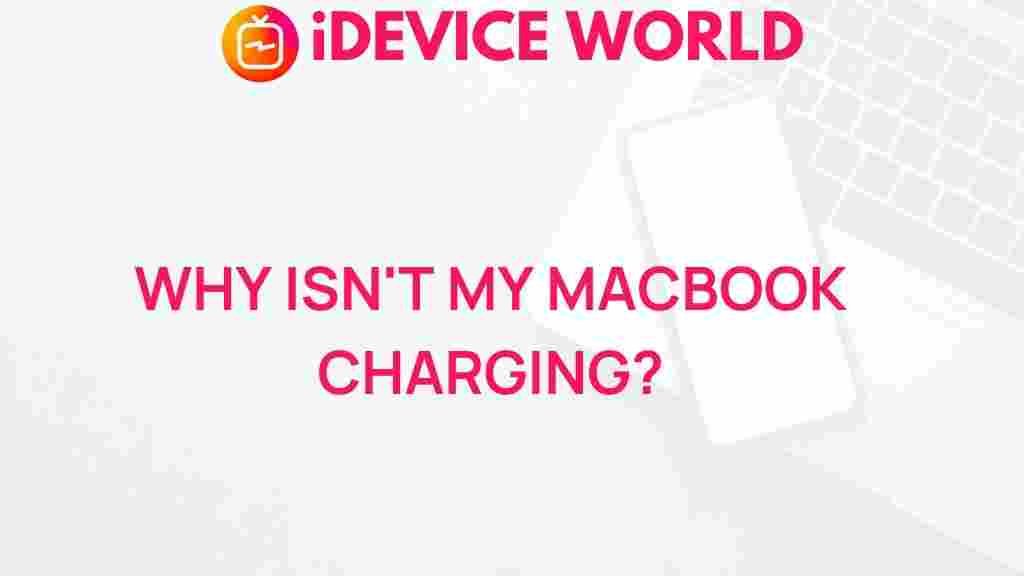Unraveling the Mystery: MacBook Not Charging Dilemma
Are you struggling with a MacBook that refuses to charge? This frustrating issue can disrupt your workflow and leave you feeling helpless. Understanding why your MacBook isn’t charging and knowing how to address the problem is crucial. In this article, we will delve into the reasons behind this dilemma and provide step-by-step troubleshooting tips to help you get your MacBook back on track.
Understanding the Charging Process of a MacBook
Before we dive into troubleshooting, it’s essential to understand how your MacBook charges. A typical charging process involves:
- The power adapter providing electrical current to the battery.
- The MagSafe or USB-C port acting as the connection point for the charger.
- The battery management system regulating the charging process to ensure optimal battery health.
Any disruption in this process can lead to charging issues. Let’s explore some common reasons why your MacBook may not be charging.
Common Causes of MacBook Charging Issues
- Faulty Charger: One of the most common issues is a malfunctioning charger. Check for visible damage on the cable and adapter.
- Port Problems: Dust or debris in the charging port can prevent a proper connection.
- Battery Health: An aging or damaged battery may not hold a charge, leading to charging issues.
- Software Glitches: Occasionally, software bugs can interfere with the charging process.
Step-by-Step Troubleshooting Process
Now that we understand the potential causes, let’s go through a systematic approach to troubleshoot the charging issue.
Step 1: Check the Power Source
Ensure the power outlet is functioning correctly:
- Plug another device into the same outlet to confirm it works.
- Try using a different outlet if necessary.
Step 2: Inspect the Charger
Examine your charger for any signs of damage:
- Look for frays or bends in the cable.
- Check the adapter for discoloration or burn marks.
If the charger appears damaged, consider replacing it with a genuine Apple charger.
Step 3: Clean the Charging Port
Dust and debris can accumulate in the charging port:
- Use a flashlight to inspect the port.
- Gently clean it with a soft brush or compressed air.
Step 4: Reset the SMC (System Management Controller)
If your MacBook still isn’t charging, resetting the SMC may help:
- Shut down your MacBook.
- For MacBooks with T2 chip, press and hold the Control + Option + Shift keys for 7 seconds.
- While holding these keys, press and hold the Power button for an additional 7 seconds.
- Release all keys, wait a few seconds, and then turn on your MacBook.
Step 5: Check Battery Health
Assess the health of your MacBook’s battery:
- Click on the Apple logo in the top left corner.
- Select About This Mac > System Report.
- Click on Power in the left sidebar to view battery information.
If the cycle count is high or the condition shows “Service Recommended,” it may be time to replace your battery.
Troubleshooting Tips for Specific Models
Different MacBook models may have unique considerations:
- MacBook Air: Ensure you are using the correct wattage charger (usually 30W or 45W).
- MacBook Pro: Check for any software updates that may resolve charging issues.
- MacBook (Retina, 12-inch): Verify if the USB-C port is functioning by connecting other USB-C devices.
When to Seek Professional Help
If you’ve gone through all the troubleshooting steps and your MacBook is still not charging, it may be time to seek professional assistance. Here are signs that you should visit an Apple Store or authorized service provider:
- Your MacBook shows a battery icon with an “X” symbol.
- The MacBook does not turn on at all.
- You notice unusual heat from the charging port.
Professional technicians can diagnose hardware issues that may not be apparent during basic troubleshooting.
Conclusion
The MacBook not charging dilemma can be frustrating, but understanding the potential causes and following a systematic troubleshooting approach can often resolve the issue. Always begin by checking the basics, such as the power source and charger, before diving deeper into potential software or hardware issues. If all else fails, don’t hesitate to reach out to professionals for assistance.
For more tips on maintaining your MacBook, consider visiting our maintenance guide page. Remember, a well-maintained device is less likely to encounter charging issues in the first place!
This article is in the category Guides & Tutorials and created by iDeciveWorld Team
